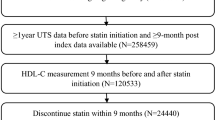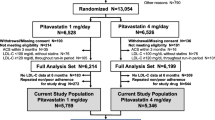Abstract
There is robust epidemiological evidence dating back to the original Framingham Heart Study from 1977 that indicates an important inverse relationship between high-density lipoprotein cholesterol (HDL-C) and risk of incident coronary artery disease (CAD). Despite this body of scientific information demonstrating that low levels of HDL-C are an independent predictor of subsequent CAD events, multiple therapeutic attempts to raise HDL-C levels have failed to demonstrate a consistent reduction in prognostically important endpoints such as death, myocardial infarction (MI), and stroke. Recently, several major randomized trials using different therapeutic interventions have raised appropriate concerns about our basic understanding of HDL-C and whether the “HDL hypothesis” of lowering cardiovascular events through therapeutic interventions directed at raising HDL-C is a scientifically viable one. While two recent randomized controlled trials (AIM-HIGH and HPS2-THRIVE) failed to show a reduction in cardiovascular events in patients treated to optimally low levels of low-density lipoprotein cholesterol (LDL-C) at baseline with extended-release niacin on a background of simvastatin, these clinical trials studied specific populations of stable ischemic heart disease patients. The data from these two contemporary trials cannot be extrapolated to all patient populations, such as those with acute coronary syndromes or myocardial infarction or those with significant residual mixed dyslipidemia not treated with optimal doses of intensive statin therapy, as these patients were excluded by trial design in both studies. Therefore, at the present time, there is insufficient evidence from clinical trials to recommend HDL-targeted therapy for additional event reduction in CAD patients. However, we will review the relevant data from recent major trials (AIM-HIGH, HPS2-THRIVE, ILLUMINATE, and dal-OUTCOMES) and highlight the potential clinical implications of these trials in modern pharmacotherapy as it relates to HDL-C raising and potential cardiovascular event reduction.

Similar content being viewed by others
References
Papers of particular interest, published recently, have been highlighted as: • Of importance •• Of major importance
National Cholesterol Education Program (NCEP) Expert Panel on Detection, and Treatment of High Blood Cholesterol in Adults (Adult Treatment Panel III). Third report of the National Cholesterol Education Program (NCEP) expert panel on detection, evaluation, and treatment of high blood cholesterol in adults (adult treatment panel III) final report. Circulation. 2002;106(25):3143–421.
Stone NJ, Robinson J, Lichtenstein AH, et al. 2013 ACC/AHA guideline on the treatment of blood cholesterol to reduce atherosclerotic cardiovascular risk in adults: a report of the American College of Cardiology/American Heart Association Task Force on Practice Guidelines. J Am Coll Cardiol. 2013. doi:10.1016/j.jacc.2013.11.002. The controversial new 2013 AHA/ACC cholesterol treatment guidelines released in November of 2013 have now eliminated LDL-C and non-HDL-C risk-stratified treatment thresholds and targets. These guidelines now define patient eligibility for treatment of dyslipidemia with a statin-based regimen solely on the projected risk for an atherosclerotic disease-related cardiovascular event.
Ridker PM, Cook NR. Statins: new American guidelines for prevention of cardiovascular disease. Lancet. 2013;382(9906):1762–5.
Kannel WB, Dawber TR, Friedman GD, et al. Risk factors in coronary heart disease. An evaluation of several serum lipids as predictors of coronary heart disease; The Framingham Study. Ann Intern Med. 1964;61:888–99.
Castelli WP. Cholesterol and lipids in the risk of coronary artery disease–the Framingham Heart Study. Can J Cardiol. 1988;4(Suppl A):5A–10A.
The Coronary Drug Project Research Group. JAMA. 1972;221(8):918.
The Coronary Drug Project Research Group. Clofibrate and niacin in coronary heart disease. JAMA. 1975;231(4):360–81.
Canner PL, Berge KG, Wenger NK, et al. Fifteen year mortality in coronary drug project patients: long-term benefit with niacin. J Am Coll Cardiol. 1986;8(6):1245–55.
Ridker PM, Danielson E, Fonseca FA, Genest J, Gotto Jr AM, Kastelein JJ, et al. Rosuvastatin to prevent vascular events in men and women with elevated C-reactive protein. N Engl J Med. 2008;359:2195–207.
LaRosa JC, Grundy SM, Waters DD, Shear C, Barter P, Fruchart JC, et al. Intensive lipid lowering with atorvastatin in patients with stable coronary disease. N Engl J Med. 2005;352:1425–35.
Scandinavian Simvastatin Survival Study Group. Randomized trial of cholesterol lowering in 4444 patients with coronary heart disease: the Scandinavian Simvastatin Survival Study (4S). Lancet. 1994;344:1383–9.
Sacks FM, Pfeffer MA, Moye LA, et al. The effect of pravastatin on coronary events after myocardial infarction in patients with average cholesterol levels. N Engl J Med. 1996;335:1001–9.
The Long-Term Intervention with Pravastatin in Ischemic Disease (LIPID) Study Group. Prevention of cardiovascular events and death with pravastatin in patients with coronary heart disease and a broad range of initial cholesterol levels. N Engl J Med. 1998;339:1349–57.
Jafri H, Alsheikh-Ali AA, Karas RH. Meta-analysis: statin therapy does not alter the association between low levels of high-density lipoprotein cholesterol and increased cardiovascular risk. Ann Intern Med. 2010;153(12):800–8.
Bezafibrate Infarction Prevention (BIP) study. Secondary prevention by raising HDL cholesterol and reducing triglycerides in patients with coronary artery disease: the Bezafibrate Infarction Prevention (BIP) study. Circulation. 2000;102(1):21–7.
Wilson PW, D’Agostino RB, Levy D, Belanger AM, Silbershatz H, Kannel WB. Prediction of coronary heart disease using risk factor categories. Circulation. 1998;97(18):1837–47.
Gordon T, Castelli WP, Hjortland MC, Kannel WB, Dawber TR. High density lipoprotein as a protective factor against coronary heart disease. The Framingham Study. Am J Med. 1977;62(5):707–14.
Rubins HB, Robins SJ, Collins D, et al. Distribution of lipids in 8,500 men with coronary artery disease. Department of Veterans Affairs HDL Intervention Trial Study Group. Am J Cardiol. 1995;75(17):1196–201.
Rubins HB, Robins SJ, Collins D, et al. Gemfibrozil for the secondary prevention of coronary heart disease in men with low levels of high-density lipoprotein cholesterol. For the Veterans Affairs High-Density Lipoprotein Cholesterol Intervention Trial Study Group. N Engl J Med. 1999;341(6):410–8.
Boden WE, Probstfield JL, Anderson T, et al. Niacin in patients with low HDL cholesterol levels receiving intensive statin therapy. N Engl J Med. 2011;365(24):2255–67. The Atherothrombosis Intervention in Metabolic Syndrome with Low HDL/High Triglycerides and Impact on Global Health Outcomes (AIM-HIGH) was the first prospective randomized, placebo-controlled clinical trial in patients with a history of CHD and atherogenic dyslipidemia (low HDL-C and high triglycerides) with a hypothesis that raising HDL-C with ERN would reduce the risk of CV events among patients who had achieved target levels of LDL-C (40 to 80 mg/dL) with intensive simvastatin + ezetimibe therapy 10 mg daily, as needed, in either arm.
Armitage J et al. HPS2-THRIVE: randomized placebo controlled trial of ER Niacin and laropiprant in 25,673 patients with pre-existing cardiovascular disease. Eur Heart J. 2013;34(17):1279–91. The Second Heart Protection Study (HPS2-THRIVE) trial was the largest international prospective double-blind secondary prevention trial with niacin to date, undertaken in 25,673 participants from the UK, Scandinavia, and China who were randomized either to extended-release niacin (ERN) combined with laropiprant (LRPT) 2 grams daily, a prostaglandin inhibitor, or matching placebo on top of a background of intensive LDL-C reduction therapy with simvastatin 40 mg daily (with or without ezetimibe 10 mg/daily).
Schwartz GG, Olsson AG, Abt M, et al. Effects of dalcetrapib in patients with a recent acute coronary syndrome. N Engl J Med. 2012;367(22):2089–99.
Wolfram RM, Brewer HB, Xue Z, et al. Impact of low high-density lipoproteins on in-hospital events and one-year clinical outcomes in patients with non-ST-elevation myocardial infarction acute coronary syndrome treated with drug-eluting stent implantation. Am J Cardiol. 2006;98(6):711–7.
Acharjee S, Roe MT, Amsterdam EA, et al. Relation of admission high-density lipoprotein cholesterol level and in-hospital mortality in patients with acute non-ST segment elevation myocardial infarction (from the National Cardiovascular Data Registry). Am J Cardiol. 2013;112(8):1057–62.
Boden WE, O’Rourke RA, Teo KK, et al. Optimal medical therapy with or without PCI for stable coronary disease. N Engl J Med. 2007;356(15):1503–16.
Acharjee S, Boden WE, Hartigan PM, et al. Low levels of high-density lipoprotein cholesterol and increased risk of cardiovascular events in stable ischemic heart disease patients: a post-hoc analysis from the COURAGE Trial. J Am Coll Cardiol. 2013;62:1826–33. doi:10.1016/j.jacc.2013.07.051.
Fisher EA, Feig JE, Hewing B, Hazen SL, Smith JD. High-density lipoprotein function, dysfunction, and reverse cholesterol transport. Arterioscler Thromb Vasc Biol. 2012;32(12):2813–20.
Cuchel M, Rader DJ. Macrophage reverse cholesterol transport: key to the regression of atherosclerosis? Circulation. 2006;113:2548–55.
Brewer Jr HB, Remaley AT, Neufeld EB, Basso F, Joyce C. Regulation of plasma high-density lipoprotein levels by the ABCA1 transporter and the emerging role of high-density lipoprotein in the treatment of cardiovascular disease. Arterioscler Thromb Vasc Biol. 2004;24:1755–60.
Rigotti A, Miettinen HE, Krieger M. The role of the high-density lipoprotein receptor SR-BI in the lipid metabolism of endocrine and other tissues. Endocr Rev. 2003;24:357–87.
Khera AV, Cuchel M, de la Llera-Moya M, Rodrigues A, Burke MF, Jafri K, et al. Cholesterol efflux capacity, high-density lipoprotein function, and atherosclerosis. N Engl J Med. 2011;364:127–35.
Bonow, Mann, Zipes, Libby. Braunwald’s heart disease: A textbook of cardiovascular medicine, vol. 1. 9th ed. Philadelphia: Saunders Elsevier; 2012. p. 975–82.
Toth PP. Model of reverse cholesterol transport torcetrapib and atherosclerosis: what happened and where do we go from here? Futur Lipidol. 2007;2(3):277–84.
Hovingh GK, de Groot E, van der Steeg W, et al. Inherited disorders of HDL metabolism and atherosclerosis. Curr Opin Lipidol. 2005;16(2):139–45.
Sirtori CR, Calabresi L, Franceschini G, et al. Cardiovascular status of carriers of the apolipoprotein A-I (Milano) mutant: the Limone sul Garda study. Circulation. 2001;103(15):1949–54.
Barter PJ, Caulfield M, Eriksson M, et al. Effects of torcetrapib in patients at high risk for coronary events. N Engl J Med. 2007;357(21):2109–22.
Randomized EValuation of the Effects of Anacetrapib Through Lipid-modification (REVEAL). ClinicalTrials.gov Identifier: NCT01252953.
A Study of Evacetrapib in High-Risk Vascular Disease (ACCELERATE). ClinicalTrials.gov Identifier:NCT01687998.
Wu BJ, Yan L, Charlton F, et al. Evidence that Niacin Inhibits acute vascular inflammation and improves endothelial dysfunction independent of changes in plasma lipids. Arterioscler Thromb Vasc Biol. 2010;30(5):968–75.
Kuvin JT, Patel AR, Sidhu MS, et al. Relationship between high density lipoprotein (HDL) cholesterol and peripheral vasomotor function. Am J Cardiol. 2003;92(3):275–9.
Keech A, Simes RJ, Barter P, et al. Effects of long-term fenofibrate therapy on cardiovascular events in 9795 people with type 2 diabetes mellitus (the FIELD study): randomised controlled trial. Lancet. 2005;366(9500):1849–61.
The ACCORD Study Group. Effects of combination lipid therapy in type 2 diabetes mellitus. N Engl J Med. 2010;362:1563–74.
Manninen V, Elo MO, Frick MH, et al. Lipid alterations and decline in the incidence of coronary heart disease in the Helsinki Heart Study. JAMA. 1988;260(5):641–51.
Brown BG, Zhao XQ, Chait A, et al. Simvastatin and niacin, antioxidant vitamins, or the combination for the prevention of coronary disease. N Engl J Med. 2001;345(22):1583–92.
Boden WE, Sidhu MS, Toth PP. The Therapeutic Role of Niacin in Dyslipidemia Management. J Cardiovasc Pharmacol Ther. 2014;19(2):141–58.
Landmesser U. The difficult search for a ‘partner’ of statins in lipid-targeted prevention of vascular events: the re-emergence and fall of niacin. Eur Heart J. 2013;34(17):1254–7. doi:10.1093/eurheartj/eht055.
van de Woestijne AP, van der Graaf Y, Liem AH, Cramer MJM, Westerink J, Visseren FLJ, et al. Low high-density lipoprotein cholesterol is not a risk factor for recurrent vascular events in patients with vascular disease on intensive lipid-lowering medication. J Am Coll Cardiol. 2013;62(20):1834–41. doi:10.1016/j.jacc.2013.04.101.
Compliance with Ethics Guidelines
Conflict of Interest
Sayed M. Tariq, Mandeep S. Sidhu, and William E. Boden declare that they have no conflict of interest.
Peter P. Toth is a consultant to Amgen, Atherotech, Kowa, Liposcience, Merck, and Novartis; received payment for development of educational presentations from Amarin, Genzyme, GSK, Kowa, and Merck.
Human and Animal Rights and Informed Consent
This article does not contain any studies with human or animal subjects performed by any of the authors.
Author information
Authors and Affiliations
Corresponding author
Additional information
This article is part of Topical Collection on Nonstatin Drugs
Rights and permissions
About this article
Cite this article
Tariq, S.M., Sidhu, M.S., Toth, P.P. et al. HDL Hypothesis: Where Do We Stand Now?. Curr Atheroscler Rep 16, 398 (2014). https://doi.org/10.1007/s11883-014-0398-0
Published:
DOI: https://doi.org/10.1007/s11883-014-0398-0




